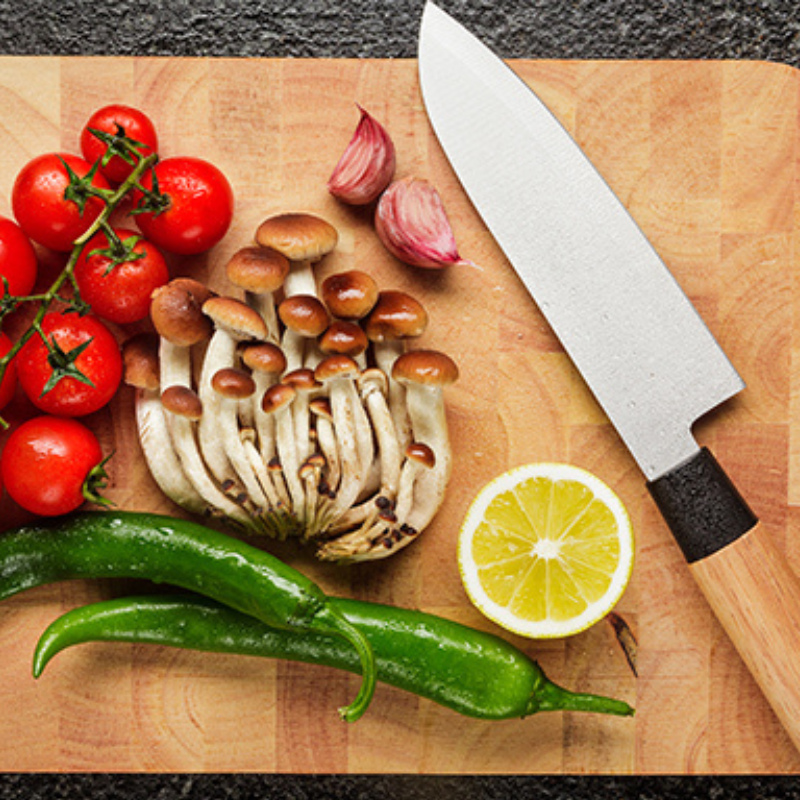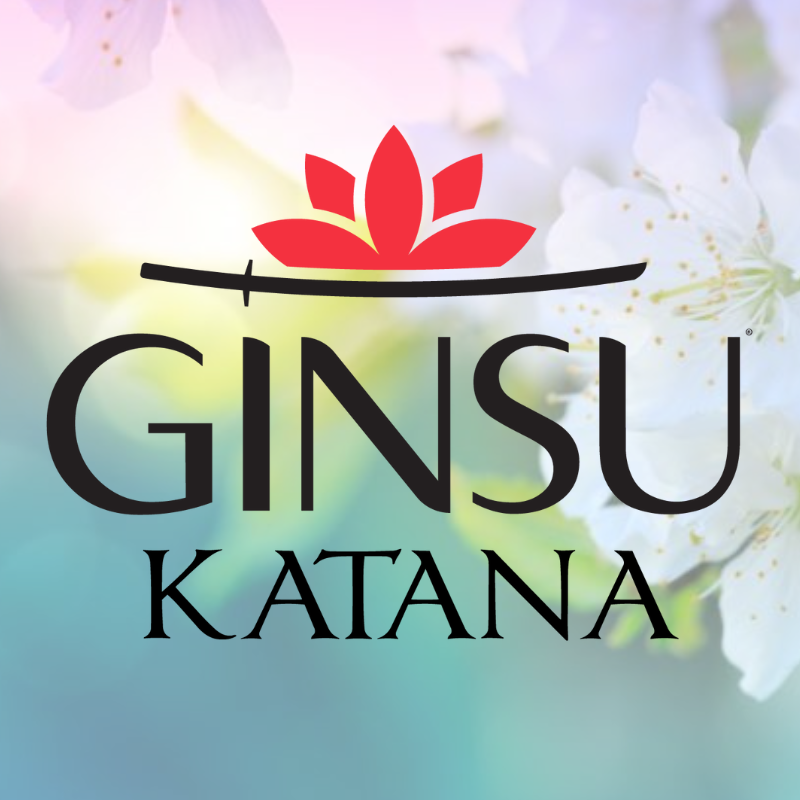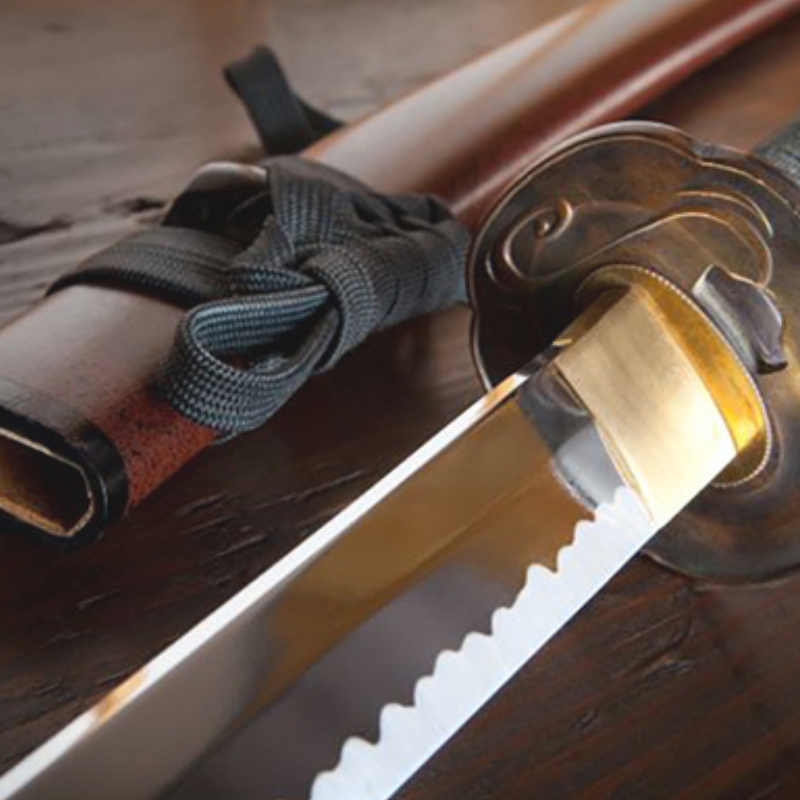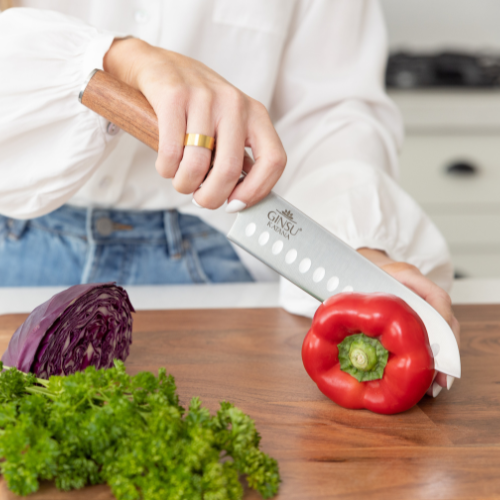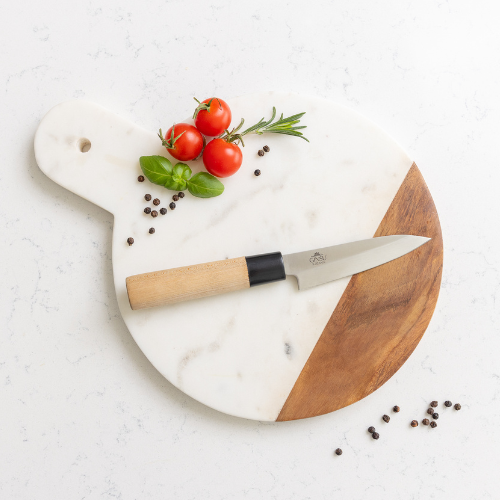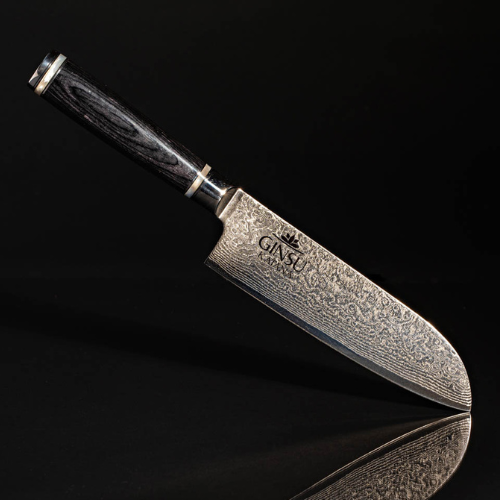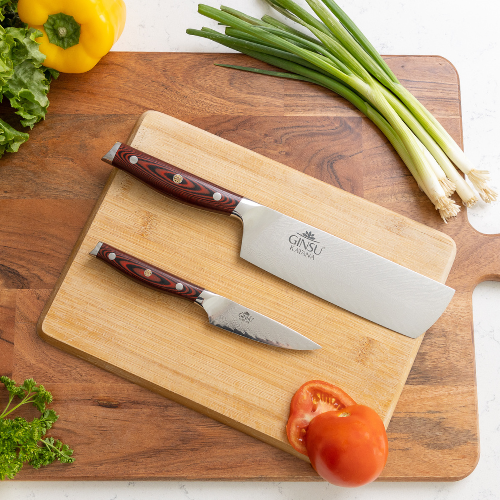WHY ARE SOME KNIVES MORE EXPENSIVE THAN OTHERS? IS THERE A BIG DIFFERENCE?
The quality and the price of a kitchen knife are determined by:
· Quality of steel
· The method used for transforming steel into a blade and hardening
· How sharp the blade is and how long it maintains sharpness
· How frequent is sharpening necessary
· Balance between blade and handle
WHAT KIND OF METAL SHOULD MY KNIVES BE MADE WITH?
Stainless steel is the best option when looking for a quality knife. Typical stainless steel used in knife-making includes 420 (cutlery grade stainless steel), 440 (higher grade cutlery stainless steel that has more hardness and edge retention) and AUS 10 ( rust resistant with a Rockwell rating of 58-60HRC due to the high chromium content).
WHAT IS THE DIFFERENCE BETWEEN THE DIFFERENT TYPES OF STEEL? WHICH ONE IS THE BEST?
Every GINSU KATANA blade is made with steel that has rust-resistant components to help reduce corrosion and staining from storage, carry, and use.
(Good) Steel in the 420 family has been used for knives for quite some time for ease of sharpening, medium edge retention, considerable toughness and high corrosion resistance.
(Better) Steel in the 440 family offers better edge retention than the 420 family. It's also known for its ease of sharpening, medium toughness, medium edge retention and high corrosion resistance.
(Best) Steel in the AUS 10 family offers solid, resistant stainless steel that can withstand rust and has exceptional edge retention. The hardness of AUS-10 steel is mostly due to the incredibly high carbon-content. As a result, the knives are easily sharpened leaving you with razor-sharp results.
(Superior) Our AUS 10 Damascus (67 layers)is the material that skilled home cooks and professional chefs prefer. With exceptional durability, it holds an edge the longest of all the blades, and, is beautiful.
WHAT DOES DAMASCUS MEAN? IS THE DESIGN DECORATIVE?
Damascus is the technique used to make the steel that creates the wavy design in the blade. It's created by hammer-welding strips of steel and iron followed by repeated heating and forging. This signature pattern on the blade is what makes a "Damascus” knife, "Damascus" . The Damascus pattern is not decorative, but is the result of the method that alloys are applied in the process to the steel, chromium, molybdenum and vanadium.
WHAT IS THE SYMBOL ON THE HANDLE OF THE KNIVES? WHAT DOES IT MEAN?
The Japanese Kanji symbol featured on our knives translates directly to "strength". This symbol was chosen to continuously promote the message of strength, forever honoring origins and traditions, and to speak to the true quality of our knife collection.
WHAT IS THE DIFFERENCE BETWEEN FORGED AND STAMPED KNIVES?
Forged Knives are heavier and thicker than stamped knives. In the manufacturing process, bolsters are applied to forged knives that increase their weight. Bolsters add a layer of protection to your fingers by providing a natural stop to their movement. The weight provides a well-balanced blade for seamless cutting exercises, even during heavy cuts.
Stamped Knives are cut from a sheet of steel, making them thinner, lighter, and more flexible compared to forged knives. Professional chefs generally favor stamped knives because their lighter frame making for less fatigue during use. A thinner blade helps cut through foods easier. Count on stamped knives for smooth slicing. Stamped knives typically have no bolster, so they’re easier and more convenient to sharpen from tip to heel. They come either in a partial tang or a full tang, which is the part of the knife blade that extends into the handle. Knowing if it is full or partial tang can be acheived by looking at the bottom and top of the knife handle. If there is metal on its top, but not its bottom, it may be a partial tang.
WHAT IS THE DIFFERENCE BETWEEN SINGLE AND DOUBLE BEVEL?
Single Bevel knives are favored in specific types of cooking, such as Japanese, as they they are extremely sharp – a key advantage. Because they only need to be honed on one side, it is easier to create a much smaller, sharper, angle. This allows for precision slicing, dicing and cutting, essential in Japanese cuisine, particularly when crafting sushi. A single bevel knife also allows the chef to make long, unbroken, wafer-like cuts, which is very important when preparing many Japanese vegetables. It is difficult to achieve unbroken cuts such as these with a double-bevel knife.
Double Bevel knives are used for a wide variety of tasks that to do not involve extremely intricate work such as cutting fish to make sushi or peeling long, unbroken pieces of thin vegetables. Most European knives are double-beveled. They come in a variety of edge styles with the most common being a V-shape, however there are also compound (double-layered V edge) and convex shapes.
HOW DO YOU PROPERLY HOLD A KNIFE?
Proper Grip:
The Index finger and thumb should be opposite each other on either side of the blade while the remaining three fingers are sort of loosely curled around the handle. Grip the knife mainly with the thumb and forefinger.
Guide Hand:
Make sure to keep your fingers tucked away. Keep your fingers curled inward and gripping the food with the knuckles, keeping your fingers out of harms way. The side of the knife blade should rest against the first knuckle of the guide hand.
HOW DO I CHOOSE THE RIGHT KNIFE?
We have an entire Buying Guide page dedicated to helping you know which knife is best suited for you. But in short, here are some recommendations:
When looking for a multi-purpose knife for cutting larger quantities of meat, fish and vegetables, the Gyuto or Chef's Knife is an excellent choice.
For a shorter blade for general cutting, dicing, and chopping, Santoku knives are the way to go.
An even more vegetable-oriented knife is the Nakiri, perfect for precision cutting, slicing, dicing, and mincing.
The wider Gyuto are best suited for large pieces of meat and fish.
The Petty knife was made specifically for peeling, precision cutting, and small decorative cuts.
I CAN ONLY BUY ONE KNIFE - WHICH ONE WOULD YOU RECOMMEND?
The Santoku (three virtues) knife it’s the most commonly use in any kitchen in the world because of its incredible versatility in the kitchen.
We recommend our 7” Santoku GINSU KATANA Legacy for its amazing quality as well as effectiveness.
DO YOU SELL SETS?
While we currently don't sell our knives in sets, we encourage collecting knives offered within one collection.
WHICH KNIVES ARE GOOD, BETTER, AND BEST?
(Good) Our GINSU KATANA Origins knives are made with Japanese Stainless Steel 420J2,offering excellent corrosion resistance because of the high levels of chromium in its composition.
(Better) Our Traditions knives are made with Japanese Stainless Steel 440A, with an excellent corrosion resistance due to the high chromium content (18%), which is quite high compared to other steel.
(Best) The Heritage Collection flaunts stunning Damascus (67 layers) high carbon steel. Forged full tang in one piece with Japanese stainless steel, AUS-10, Damascus knives are legendary for their sharpness.
(Superior) The stunning Legacy Santoku Damascus (67 layers) knife is made with stainless steel AUS-10 by Aichi Steel in Tokai, Japan. With the addition of nickel, maganese, and silicon, this blade is rock solid and knows how to hold a sharp edge.
HOW DO I KNOW WHICH HANDLE TO CHOOSE?
Any of the GINSU KATANA handles are the best on the market for their beauty and durability.
DO THE KNIVES COME WITH ANY SHEATHS OR A STORAGE BLOCK?
The 7" Santoku Legacy Knife comes with a wooden Saya or "sleeve” for storage. All other knives can easily be stored in a block, drawer, or on a magnetic strip.
HOW SHOULD I STORE MY KNIVES?
Place your GINSU knives in a countertop knife block, divider drawers, on wall-mounted magnetic strips or in a Saya. Choose what is best depending on your preference.
WHAT IS THE BEST WAY TO WASH MY KNIVES? ARE THESE DISHWASHER SAFE?
Our GINSU KATANA knives are NOT dishwasher safe. Please hand wash your GINSU KATANA knives with mild soap, rinse and hand dry.
WHAT IS THE BEST WAY TO SHARPEN MY KNIVES? HOW OFTEN SHOULD I SHARPEN THEM?
Sharpen your knives using a sharpening stone. Not only will it carve the best edge, it will also remove the least amount of material in the process.
Our GINSU KATANA knives retain their edge for a long time. Sharpening them once a year should suffice, but it depends upon their use.
WHAT TYPE OF CUTTING BOARD SHOULD I USE? DOES IT MATTER?
Wood is always preferred as a cutting surface. Softer woods like maple and walnut provide the best surface. Avoid marble, steel, glass or ceramic material as they can dull and/or chip the blade.
DO I NEED TO MAINTAIN THE HANLDE ON MY KNIVES?
No extra measures need to be taken to maintain the handle. All of our GINSU KATANA handles are durable and highly resistant to moisture, and should be washed and cared for in the same manner as the blades: hand wash with mild soap, rinse, and dry.
WHEN WILL I GET MY KNIVES AFTER PLACING AN ORDER?
Shipments are sent out 24-48 hours after an order is received. Shipping typically takes 2-5 days depending upon the time and day the order is placed and where we are shipping product.
CAN I RETURN MY KNIVES?
GINSU KATANA knives can be returned within 15 days of delivery for any manufacture defect, or if not satisfied with their performance. We warranty the GINSU KATANA line of knives, and are confident that our Japanese steel will not disappoint.
HOW LONG DO I HAVE TO RETURN?
You may return your knives within 15 days from the day they are delivered to your doorstep.
DO THESE KNIVES COME WITH A WARRANTY?
Yes! We have a limited lifetime warranty that guarantees our knives against any manufacturing defects in material and construction, and to perform as advertised when properly used and maintained.


